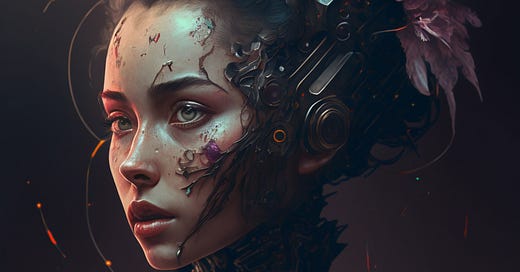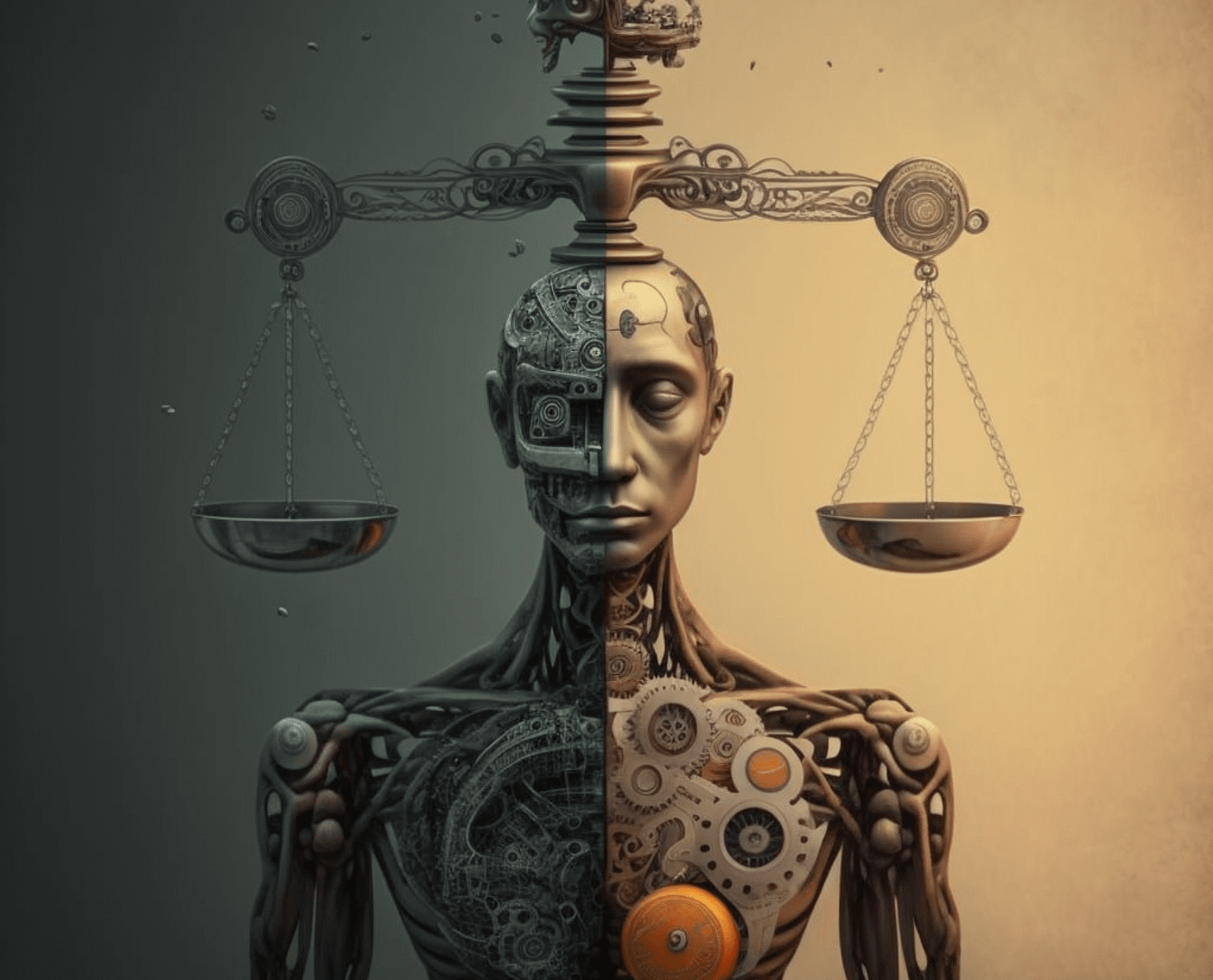Our intuition about the future is linear. But the reality of information technology is exponential, and that makes a profound difference. If I take 30 steps linearly, I get to 30. If I take 30 steps exponentially, I get to a billion.- Ray Kurzweil
I recently indulged myself by going down a rabbit hole of playful nihilism, writing If All Goes Wrong, a letter in which I envisioned many of the worst case scenarios for NFTs & blockchain technology, soulbound tokens, and artificial general intelligence.
While it’s our most read letter yet (🥳) and we gained many subscribers, I also noticed a few users drop off for the first time. To those who left because I bummed them out, I do apologize—the bear market is depressing enough without me pondering everything from targeted discrimination to world annihilation.
At the other end, some remarked that I may have held my punches and not imagined things as dark as they could go. To that I say two things: first, I think the total extinction of human civilization is pretty dark, and two, touché. I probably could have gone significantly more detailed into the misery that this technology could inflict upon us in a worst case scenario. In truth, I guess I’ve just become more excited about the future of this technology over time.
And it is in that spirit of equal opportunity that I’d like to put on my rose-tinted glasses and provide a counterpart to last week’s article. This time around, we’ll be examining where NFTs and blockchain tech, soulbound tokens, and artificial general intelligence could lead us, should we get everything right.
What’s the best that could happen? 😊
NFTs & Blockchain Technology
For the first time, we’re able to know with 100% certainty the authenticity of digital assets. This is a boon for collectors and admirers of art who can be confident in the genuine nature of their purchases, knowing that fraud has been eliminated (or at the very least, always detectable) in the world of NFTs.
The central goal that crypto and DeFi continues to push for is decentralizing financial systems free from the control of banks, politicians, or even governments. This new way of doing things promises full autonomy, allowing for complete self-custody over one’s assets. While we’re already moving in the right direction, a utopian future where everything goes right would see these systems become the norm, strengthening the financial independence of every citizen and upholding transparency for our economic system at large.
But it’s not just financial independence that the blockchain provides. It can offer real, tangible security in critical moments as well. Refugees fleeing their homeland and settling abroad could easily access their funds from anywhere in the world, providing a safety net not afforded by traditional financial systems. More importantly, those funds would be safe from the seizure of despots, militia groups, tyrannical governments, or sudden hostile takeovers.
It’s not just abroad that blockchain technology will make a difference. With the curtain lifted on countries’ finances, governments would no longer have a cloak of obfuscation over how money is spent. A new level of financial transparency could be achieved, all in full display of the public. This public scrutiny would go a long way towards increasing the accountability of our government’s actions.
And it’s not just governmental misappropriation that could be stopped. Financial crimes on Wall Street would become a thing of the past as well. People like Bernie Madoff would never be able to manage the 60+ billion dollar Ponzi he committed over more than two decades, had it taken place on the blockchain. The scam would have been spotted in a matter of hours, not years.
Soulbound Tokens
As some of our readers may know, soulbound tokens are otherwise normal NFTs that have been specifically configured not to allow buying, selling, or trading.
As we’ve established in previous letters, while this may seem baffling at first, there are actually many potential use cases for the future of SBTs: Diplomas, certificates, identification, insurance records, medical records, flight records, group affiliations, voting records, proof of training, and proof of attendance are just a few of their potential applications. With the inability to transfer, soulbound tokens ensure that they always remain on their intended wallet, and would even provide an additional layer of security in the event of a wallet being compromised.
SBTs have their place in DeFi as well. It is not unimaginable to assume that SBTs could be used to verify a potential borrowers’ credit profile and financial history when determining how much could be safely lent to the user.
Gaming Applications of SBTs
Part of the appeal of NFTs for gamers is that they can, for the first time, actually own the assets they acquire in-game, and buy, sell, or trade said assets to other players. NFT games have also helped further the adoption of the P2E (play-to-earn) model, incentivizing gamers to earn tokens or assets simply by playing the game.
When we consider the future use of SBTs in the world of gaming, a couple things immediately come to mind. First, SBTs could allow players to build trust and reputation through their digital identity. Imagine an SBT issued to you by your gaming platform of choice: on it, all of your past major achievements, records, purchase history, player conduct details, etc. This sort of information would be exceptionally useful for online gaming, particularly when it comes to being matched with players of a similar rank or skill level. And, as all of the data would be accurate, impossible to falsify, and on the blockchain, guilds and professional esports teams could use them for research in determining which players to recruit.
On the less competitive side of gaming, SBTs would also be a natural extension of the achievement and trophy systems of Sony, Microsoft, and Steam, providing bragging rights (and perhaps additional SBT rewards) for gamers wishing to show off their in-game accomplishments.
An Art Application for SBTs
Art is a semi-recurring topic on this newsletter (The Case For and Against AI Art | How NFTs Can Save the World from Traditional Art). And for good reason: there are countless benefits to artists adopting and embracing NFTs and blockchain technology: we provide several of those reasons on our HeyMint blog article, NFT Art: 7 Reasons Why You Should Make It.
Some benefits include: being cheaper to make and distribute their work, being greener for the environment than traditional art, using less resources, perpetual royalties on artwork, experimentation only possible in digital mediums, and more. We won’t beat a dead horse again in this letter, but it needed to be said.
There is, however, a small future use case for SBTs which creators may find helpful in connecting with their community: recognition pieces.
Artists could use SBTs to gift rare or limited recognition pieces as a thank you to their most devoted or prominent collectors of their work. This would be a unique way to show appreciation, serving as acknowledgement of their patronage, and, because SBTs cannot be sold or transferred, would ensure that only the intended recipient ever owned the piece.
AI/AGI
I like to dip and daddle with my robot friend
He's smart as can be and emotion-free,
And he's computin' his way to my heart,
My robot friend
- Leopold "Butters" Stotch
Much like the previous letter where I saw the most devastating potential outcomes of technology coming from the world of AI/AGI, so too do I find the reverse: the global impact of this technology will be profound, and its potential benefits are innumerable.
Automation/Repetition
We’ve already seen great strides to use this technology in factories and plants worldwide. Automation and AI have already transformed the manufacturing industry, where it has streamlined repetitive tasks, and increased productivity.
As AI develops, not only will this continue, but it will accelerate as AI iterates upon itself and finds increasingly more effective ways to build and improve. The process is cyclical, with AI providing direction to automation, and the data from automation providing new info for AI to further improve upon.
But it’s not just factories which could see major changes. Any time-consuming, repetitive task is an ideal candidate for automation and AI implementation.
Healthcare
As we’ve touched upon in previous articles, AI is already saving lives. AI-based medical imaging is used to discover tumors and other abnormalities during MRIs, detecting it both earlier and more frequently than trained staff.
AI is also poised to revolutionize prosthetic limbs. In recent tests, three subjects received microelectronic implants for a period of up to 16 months and had trained AI decode the amputee’s motor intent. This resulted in the subjects performing their intended action 99.2% of the time, with a median reaction time of 0.81 seconds—a massive improvement from the cumbersome prosthetics on the market today.
The application of AI in healthcare continues to grow in fields as diverse as eye screening to drug discovery and development. And, unlike humans, AI never has a bad day or misses a vital piece of information when it is tired. That cannot be overstated enough, as time of discovery and finding treatment can be a matter of life or death.
Two of the loftiest goals for AI/AGI in healthcare are undoubtedly its future use with the brain, and genetics. Companies like Neuralink are already working to build brain chip interfaces which could be embedded in the skull and help with everything from restoring vision, to facilitating communication for people with disabilities.
AI also has the capability to significantly shape the future of genetics and medicine. Its advancements in analyzing genetic data and detecting harmful genes will go a long way in the creation of sophisticated vaccines and gene therapies. The integration of AI with cutting-edge techniques like CRISPR gene editing has the potential to one day transform and revolutionize the medical industry and the human lifespan.
While merging the human with the the synthetic may seem like a far-fetched dream for the moment, so too was all of the technology we take for granted today.
Astronomy
Already showing promise to astronomers, AI has been developed to analyze astronomical data and patterns, looking at even the most minuscule and intricate details in our survey of the stars. This technology shows promise in assisting researchers in making new discoveries and insights into the nature of the cosmos.
On a more terrestrial level, NASA just announced that they’re working with AI powered by IBM to research the impact of climate change.
Transportation
Driver-assisted technology and autopilot-enabled vehicles are already on the market. And while neither Tesla nor Google can lay a claim on “fully autonomous” automobiles as of yet, it goes without saying that it’s only a matter of time.
Despite ongoing concerns about their safety compared to human drivers, that debate will be all but settled in a matter of years. The fact remains that autonomous vehicles have the potential to significantly improve road safety. Powered by AI algorithms, self-driving cars are immune to distractions like fatigue or alcohol, can monitor all surrounding traffic to optimize the flow, and have the ability to anticipate events miles ahead.
The end result is a future where transportation is safe, efficient, and driverless.
Environmental Applications
If we have any chance of survival on this planet, we’d be wise to leverage the power of AI in helping overcome our numerous manmade environmental obstacles.
AI will play a crucial role in advancing global sustainability initiatives. We can already detect energy emissions and CO2 levels and feed that data to AI to help target achievable reductions.
As it stands, we already use AI to implement eco-friendly transportation systems, monitor deforestation, identify impending drought, track and eliminate invasive species, and even anticipate extreme weather conditions. AI properly managed can help in everything from conserving resources, tending to supply chain issues, and finding new means of protecting the environment that we are unable to realize ourselves.
Perhaps one of the coolest AI applications may be in its potential to help restore coral reefs. Scientists have already developed a machine learning system that can identify healthy or unhealthy coral reefs just by analyzing the soundscapes of their ecosystem.
It’s this sort of forward-thinking technology that can give us an edge in what is undoubtedly the most pressing issue of our age.

Education
Before we work on artificial intelligence why don’t we do something about natural stupidity? — Steve Polyak
^ Sorry, but I’m a sucker for a good quote, even if it’s arguing against my actual position.
In a utopian application of the technology, AG (and one day AGI) will be used to personalize the education of students, providing custom tailored lessons and making adjustments for different learning styles. In addition, AI could be used to give private tutoring for any students who require it, as well as handling all of the mundane tasks like grading and progress reports.
AI tech in education is already being considered as to how it can address teacher shortages or provide comprehensive learning opportunities for underprivileged communities. And just like any good teacher, it would be able to iterate and improve upon itself, making adjustments based on student performance, or identifying shortcomings in its own lesson planning and execution, based off of objective data.
Our Future
Artificial intelligence will reach human levels by around 2029. Follow that out further to, say, 2045, we will have multiplied the intelligence, the human biological machine intelligence of our civilization a billion-fold. —Ray Kurzweil
What will this future shaped by the billion-fold increase in intelligence look like? Anyone tasked with answering that would be as likely to get it right as our earliest nomadic tribes would have properly guessed the specs of an iPhone 14. That is to say, it’s very improbable; we simply have no way of knowing. We’re so far in the dark about our future that we don’t even know what we don’t know.
This is where AI, and eventually, especially, AGI will thrive, in developing solutions to unforeseen and unexpected problems. Its versatility and adaptability make it invaluable; its potential contributions and impact, virtually limitless.
We’ve only seen a fraction of what NFTs and blockchain technology, soulbound tokens, and AI/AGI are capable of. Most of what I’ve shared in this week’s letter is either already in use, in development, or being considered in their respective fields.
We’re only witnessing the tip of the iceberg. With the proper guidance and—forgive me, crypto enthusiasts—regulation, we’re a stone throw away from life-changing technology that’ll shape the world for the better.
Without that guidance, it’d be like walking on the edge of a precipice, about to take a foolish step forward.
Written by: Brad Jaeger
Director of Content @ Curious Addys (say hi on Twitter or LinkedIn!)











gm gm! Excellent articulation and explanation of this nascent technology! Hope you dont mind if i retweet this article! 😎🖖🏽